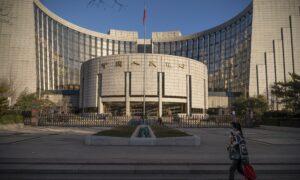China’s ambitions to establish the yuan as a formidable competitor to the dollar and to infiltrate U.S. payment networks pose significant threats to the American economy and security, warned Sen. Tim Scott (R-S.C.) and his Republican colleagues on the Senate Banking Committee.
The senators said China’s rapidly expanding payment networks could “undermine U.S. foreign policy, jeopardize Americans’ sensitive financial and consumer data privacy, and violate international trade practices.”
In addition to requesting the Biden administration to investigate the infiltration of Chinese payment networks into the United States, the senators also asked the administration “to evaluate the Chinese Communist Party’s (CCP) unfair commercial practices toward U.S. companies and review potential U.S. sanctions gaps related to China’s Cross-Border Interbank Payment System.”
“We are concerned with the CCP’s ongoing efforts to expand its footprint in the United States’ financial system and the global payments market,” the senators wrote. “The measures the CCP is taking undermine U.S. foreign policy, threaten Americans’ sensitive financial and consumer data privacy, and violate international trade practices.”
Citing the wide use of UnionPay in the United States, the senators said that its widespread acceptance has already been successful in advancing the CCP’s strategic objectives.
According to UnionPay’s website, in 2022, China UnionPay became the largest global payments network by total volume, with over 80 percent of U.S. merchants and 90 percent of automated teller machines in the United States accepting UnionPay cards.
QR Codes Replace Tin Cups
Indeed, China has taken rapid strides in the global payments sector, with its digital payment systems replacing cards and cash at registers, including how beggars ask for money using QR codes instead of tin cups, according to a Brooking’s study.The efforts, though, are not recent.
Since the global financial crisis of 2008–2009, China has been attempting to internationalize its currency through various means. However, China discontinued that initiative in 2015 to ensure domestic financial stability following the stock market crash and huge yuan depreciation that year.
Over the next few years, though, Beijing continued to try various options, such as the creation of a small offshore yuan market, a yuan-based payments system, (limited) capital account liberalization, and most recently, the introduction of a central bank digital currency or the People’s Bank of China’s digital currency to replace the use of the dollar for international payments.
However, in response to the Western sanctions following Russia’s invasion of Ukraine, Beijing has started pushing the yuan’s internationalization aggressively.
In this regard, the Belt and Road Initiative (BRI), a massive infrastructure development project launched by China in 2013, is a significant example. The initiative aims to strengthen China’s connectivity with the world by building new infrastructure and upgrading existing ones, covering an expansive geographic scope, and including efforts to strengthen hard infrastructure, soft infrastructure, and cultural ties.
At the BRI Forum in Beijing that ended on Oct. 18, China’s policy banks signed a series of yuan-denominated loan contracts with foreign lenders to promote the yuan internationally.
These include yuan-denominated loan arrangements between China Development Bank and Malaysia’s Maybank, Egypt’s central bank, and BBVA Peru to finance BRI projects. The Export-Import Bank of China negotiated a yuan-based lending deal with Saudi National Bank as well, while the Bank of China assisted Egypt in issuing Africa’s first yuan-denominated Panda bonds. Beijing additionally allocated 80 billion yuan (about $10.94 billion) to the Silk Road Fund for BRI projects.
The steep increase in U.S. interest rates has been a primary driving element behind the rise in yuan finance, reports said.
This is why the BRI has been a subject of debate among many experts and policymakers, who believe that while Beijing portrays the initiative as a benign investment and development project that is economically beneficial to all, there are strategic objectives that contradict this argument.
“Chinese policymakers have stepped up their efforts to foster the yuan as an alternative currency for international payments, especially trade, which is particularly appealing to any country that aims at bypassing Russia-related sanctions linked to the U.S. or other G7 currencies,” said a client note released on Oct. 18 by Natixis and accessed by The Epoch Times.
Since 2021 and up until June this year, the yuan share of China’s cross-border settlement rose from 15 percent to 23 percent for trade and from 21 percent to 29 percent for services, the note added.
The internationalization of the yuan also benefited China in terms of lower borrowing costs, as many countries—including Russia, Iran, Brazil, Argentina, Bangladesh, and India—have started using the currency to settle international trade obligations as sanctions against Russia for its invasion of Ukraine drained their dollar currency reserves.
“All in all, it seems that the internationalization of yuan is moving ahead in the areas where an alternative currency to the USD is needed most,” added the Natixis note.
The senators’ letter shares similar views. “China is challenging the Society for Worldwide Interbank Financial Telecommunications (‘or SWIFT’) messaging system for banks with its Cross-Border Interbank Payment System (‘or CIPS’).”
Reasons for Concern
As Beijing pushes for greater adoption of the yuan, the Chinese currency has begun to gain market share in international payments, particularly in the country’s cross-border transactions.China’s State Administration of Foreign Exchange (SAFE) revealed that the yuan eclipsed the U.S. dollar for the first time in March and became the main currency in China’s cross-border transfers.
According to SWIFT data released on Oct. 18, the yuan accounted for 3.71 percent of global payments by value in September, a record high and nearly double from 1.91 percent in January. Nonetheless, the yuan’s share is negligible compared with the dollar’s 46.6 percent.
“The renminbi has gained market share and therefore made progress in functioning as a medium of exchange in global markets,” said Goldman Sachs Intelligence in a July report, adding that the higher usage of yuan in China’s cross-border payments for trade seems relatively broad-based.
Going forward, according to the Natixis note, “despite the headwinds from the investment front due to a depreciated yuan, [its] international use may continue to be fueled by the growing needs for non-G7 currency for trade settlements and private and official financing.”
That aside, Beijing has increasingly demanded businesses to share sensitive financial and personally identifiable information data with CCP officials, said the senators.
Furthermore, while the CCP has historically used China’s banking system to serve its geopolitical objectives, its payment networks are not regulated like those in the United States, which ensure data privacy, cybersecurity, and protection against financial stability threats.
The Chinese regime does not “provide reciprocal market access for rights secured in other nations,” either. According to the letter, for nearly two decades, the CCP has blocked a World Trade Organization deal that would let U.S. payment firms compete fairly with UnionPay.
“Therefore, efforts by the CCP to infiltrate the U.S. financial system must be met with extreme scrutiny,” the letter said.







